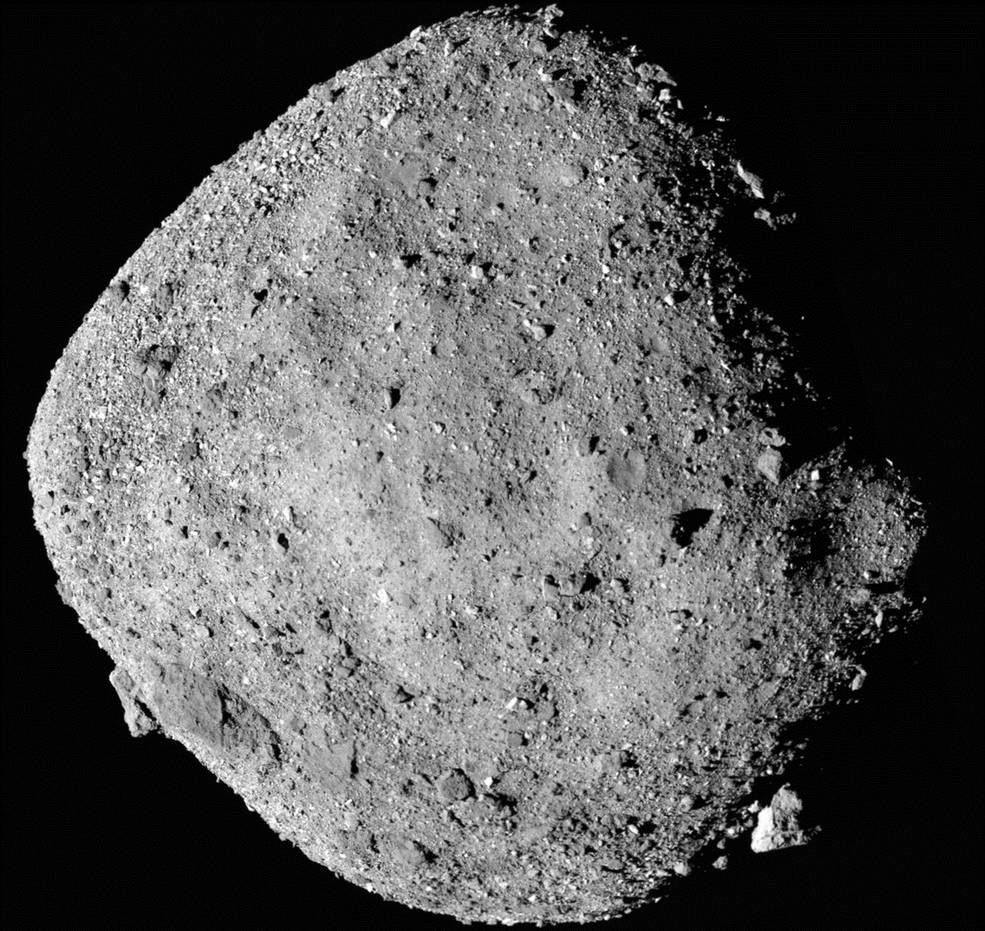Asteroids have been around since early solar system times. However, just because they are ancient bits of history doesn’t mean they don’t change. They collide, they break apart, and now, it turns out their surfaces can erode.
That’s due to heat from the Sun. It fractures surface rocks on asteroids and causes what’s called “surface regeneration”. Over time, the cracked and shattered materials can scatter across the surface or even get ejected into space.
How do we know about this erosion? Planetary scientists working on the OSIRIS-REx mission noticed that the surface of asteroid Bennu has rock fractures caused by solar heating. They found that it takes the Sun only about 10,000 to 100,000 years to break up surface rocks on asteroids. This results in a young surface topography on a piece of solar system real estate that’s billions of years old.
While a process that takes tens of thousands of years is almost unimaginable to us, it’s actually a pretty short timescale for surface changes on an asteroid. “We thought surface regeneration on asteroids took a few millions of years,” said Marco Delbo, senior scientist at Université Côte d’Azur, CNRS, Observatoire de la Côte d’Azur, Laboratoire Lagrange, Nice, France, and lead author of a paper published June 2022 in Nature Geoscience. “We were surprised to learn that the aging and weathering process on asteroids happens so quickly, geologically speaking.
” Blame Heating and Cooling So, what’s the mechanism for the quick change on asteroid surfaces such as Bennu’s? It’s clear from OSIRIS-REx images that rapid temperature changes are the culprit. Heating and cooling cause internal stress that fractures and breaks down Bennu’s rocks. Think of how ice can crack if you pour hot water over it—it’s a similar action.
How quick is the heating/cooling cycle? Well, the Sun rises every 4. 3 hours on Bennu. There’s no atmosphere, so it’s just bombarded with sunshine.
At the equator, daytime highs can reach nearly 127 C. At night, temperatures plunge to around -23 C. Given the short day/night cycle on Bennu, it experiences rapid heating and cooling swings.
Another clue to the temperature changes showed up in the actual cracks on the asteroid. Scientists measured the lengths and angles of those cracks and determined they were a clear sign of the temperature shocks between day and night. The fractures predominantly align in the northwest-southeast direction.
That indicates they were caused by the Sun, making it a primary force in changing Bennu’s landscape. “If landslides or impacts were moving boulders faster than the boulders were cracking, the fractures would point in random directions,” said Delbo. Fractures on asteroid Bennu rocks.
Credits: NASA/Goddard/University of Arizona Fractures are marked in red. Credits: NASA/Goddard/University of Arizona Linking Asteroid Surface Cracks to Long-term Solar Exposure After measuring the cracks, the science team used a computer model and fracture measurements on Bennu to calculate the timeframe for Sun-induced surface changes on Bennu. “The thermal fractures on Bennu are quite similar to what we find on Earth and on Mars in terms of how they form,” said Christophe Matonti, a co-author of the paper at Université Côte d’Azur, CNRS, Observatoire de la Côte d’Azur, Géoazur, Sophia-Antipolis, Valbonne, France.
“It is fascinating to see that they can exist and are similar in very ‘exotic’ physical conditions (low gravity, no atmosphere), even compared to Mars. ” It shouldn’t come as any surprise that asteroids such as Bennu can be modified by the Sun. Most worlds in the solar system are affected at some level by our star.
Earth certainly experiences solar-induced heating and other changes. And, of course, Earth and other planets experience a wide range of intrinsic surface changes, ranging from landslides, volcanic eruptions, and earthquakes. They make both short- and long-term alterations to the surface.
Water, wind, and temperature changes slowly break down rock layers on Earth. Wind changes Mars’s surface features, and volcanism changes Venus. So it’s no surprise Bennu is being changed, largely due to its orbit, rotation, and proximity to the Sun.
“Keep in mind, the topography of Bennu is young,” said Jason Dworkin, OSIRIS-REx project scientist at NASA’s Goddard Space Flight Center in Greenbelt, Maryland. “But the rocks on the asteroids are still billions of years old and hold valuable information about the beginning of the solar system. ” Future Studies This study of the solar-induced cracking and erosion on Bennu will help scientists estimate how long it takes boulders on asteroids like it to break down into smaller particles.
Eventually, they either eject into space or stay on the asteroid’s surface. OSIRIS-REx will return a sample from Bennu to Earth on Sept. 24, 2023.
The sample will give planetary scientists a chance to learn more details about the age of the surface. For More Information Some Asteroids “Aged Early” by Sun, NASA FindsAlignment of fractures on Bennu’s boulders indicative of rapid asteroid surface evolution The post The Sun is Eroding Asteroids appeared first on Universe Today. .
From: universetoday
URL: https://www.universetoday.com/156890/the-sun-is-eroding-asteroids/



